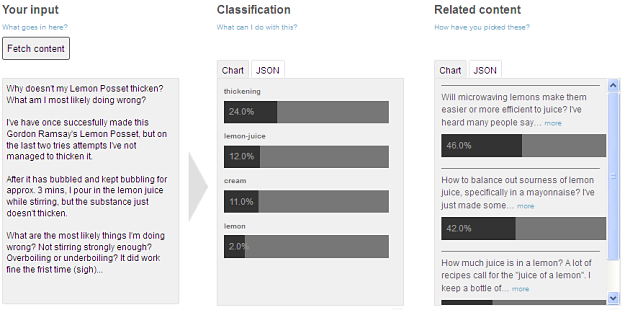Retechnica is the startup behind Ingenia. Ingenia is a text analytics API + web app that tags your content automatically. Below is our recent interview with Marco Iannone, founder and CEO of Retechnica.
 Q: Ingenia analyses textual content and automatically categorizes it using tags, tell us how long have you been working on it and where did the idea come from?
Q: Ingenia analyses textual content and automatically categorizes it using tags, tell us how long have you been working on it and where did the idea come from?
A: While my background is in applied mathematics, I have always worked in roles across business, analytics and technology, in companies diverse in terms of size, industry, and geographies. No matter the context, I have always experienced, like many others, how difficult it was to manage knowledge effectively. While knowledge management was popular some 10-15 years ago, it petered out as most of the related projects ultimately disappointed. As I started analysing the problem, I ended up zooming in on a specific aspect of it: how to organise knowledge intelligently, and specifically how machines can assist people in doing so. I picked this angle because it’s a big and fascinating problem, but also because I thought I combined a good understanding of it with the skills and background required to tackle it. A team of 3, myself and two great software developers, started Retechnica in 2012, and we soon found that in reality the solutions we were looking at were applicable not only to knowledge management, but more generally to textual content, and they involved giving a structure to what is otherwise unstructured content – what we now call “quantified text”. We also chose to make these solutions available to others via an easy-to-integrate API, and so Ingenia, Retechnica’s core product, was born.
Q: How does it work?
A: The main goal of Ingenia is to receive the content of a user as an input, and return a categorisation that best serves the user’s business goals. For that to happen, two things need to be in place: the categorisation needs to be completely customised to the user, and the user needs to be in complete control of it. This is one of the main differences between us and other similar services, and it enables us to serve a variety of use cases. In practice, the user will upload their content, broken down into chunks or what we call “items”, to Ingenia via our API: this is their “training set”. In order to instruct Ingenia about what matters to her, there are three approaches: with our “supervised” algorithm, the user will upload a sample of their items alongside manually assigned categories, or “tags”. Ingenia will then learn what each of these tags means for this user, and will be able to apply them to new relevant content that user can input via the API. This ensures the closest control over the behaviour of Ingenia, and works well if the user already has categorised content, or if it makes sense for them to create a small categorised training set. Otherwise, our semi-supervised algorithm enables a user to upload just a list of tags, and Ingenia will find content items that are “about” each of those tags – note that this is very different from looking for that tag in the text. Lastly, the user can use the “unsupervised” approach, and Ingenia will automatically generate the tags that are most suited to their content. These last two algorithms are in alpha phase, and will be released to the public within 1-2 months. It is possible to combine these approaches, and most importantly, the user can provide more input or feedback at any point, and Ingenia will continue adapting to it. In fact, Ingenia will also automatically generate suggestions to improve the user’s categorisation, via our user interface.

Q: What’s the main benefit for the users?
A: The benefits of having your content categorised in a way that is both consistent and relevant to you are several, and depend on the industry: in publishing or e-commerce, the main benefit is probably to intelligently and automatically personalise the content to each user, possibly via our own personalisation engine; when content is user-generated, as in product reviews or social media, categories enable you to analyse it to extract actionable insight. In document management, it is possible to design entire new user experiences based on this, to help employees understand what their team is working on, who they should talk to about specific topics, to avoid duplication, to easily retrieve what matters to them, or to extract the key points from a long document.
Q: What was technically the most challenging part of developing it?
A: The algorithms are the most distinctive aspects of our work: besides the classic problem of text analytics, i.e., that language is incredibly complex and multifaceted, it was very useful to find out early on that people are simply not geared to consistently categorise content: ask 3 people to assign categories to a news article, and not only they will disagree with one another, they will disagree with themselves if asked a month later. This is both an issue, as the training sets we get will tend to be inconsistently categorised, but also an opportunity, as this permits us to create great value for our users, and to further distinguish ourselves from our competitors. We also dedicated lots of energy into make the system highly scalable, and we’re reaping the rewards now.
Q: What are your plans for the future?
A: Ingenia will remain at the heart of what we do, and we will be constantly improving it, listening to the feedback from our clients. However, as Ingenia is a very versatile technology, we will also begin building end-to-end products that solve very specific use cases: we’ll have some interesting news on this within a couple of months. As Ingenia is fully automated, we can serve small and large clients alike, so we see plenty of growth coming from those direct relationships. Another great opportunity for growth is that of establishing partnerships with companies that build products that can be augmented by Ingenia: in this scenario, our incentives can be very well aligned, while we would both stay focused on our core businesses. In terms of the team, we’re 7 people now, and we’re hiring: I’m striving to make Retechnica the workplace where intelligent, innovative people can be constantly stimulated and inspired.
Activate Social Media:


